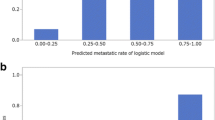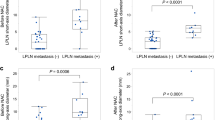Abstract
Purpose
This study seeks to evaluate lateral pelvic lymph node (LPLN) and perirectal lymph node (PRLN) status on magnetic resonance imaging (MRI) as potential risk factors for lymph node metastasis.
Methods
The subjects were 394 patients with lower rectal cancer who underwent MRI prior to mesorectal excision (combined with lateral pelvic lymph node dissection in 272 patients) at 6 institutes. No patients received neoadjuvant therapy. Cases were classified as cN(+) and cN(−) based on the short axis of the largest lymph node ≥5 and <5 mm, respectively. LPLN and PRLN status and other clinicopathologic factors were analyzed by multivariate logistic regression. The importance of identified risk factors for lymph node metastasis was examined using the area under the curve (AUC).
Results
Independent risk factors for right LPLN metastasis included histopathological grade (G3 + G4), pPRLN(+), M1, cLPLN(+) [odds ratio (OR) 10.73, 95 % confidence interval (CI) 4.59–27.1], and those for left LPLN metastasis were age (<64), histopathological grade (G3 + G4), pPRLN(+), and cLPLN(+) (OR 24.53, 95 % CI 9.16–77.7). ORs for cLPLN(+) were highest. The AUCs for right and left cLPLN status of 0.7484 (95 % CI 0.6672–0.8153) and 0.7904 (95 % CI 0.7088–0.8538), respectively, were significantly higher than those for other risk factors. In contrast, the ORs for cPRLN(+) and cPRLN status of 2.46 (95 % CI 1.47–4.18) and 0.6396 (95 % CI 0.5917–0.6848) were not much higher than for other factors.
Conclusions
An LPLN-positive status with a short axis ≥5 mm on MRI is an important predictor of LPLN metastasis, but PRLN status is not a strong predictor of PRLN metastasis.

Similar content being viewed by others
References
Koh DM, Brown G, Husband JE (2006) Nodal staging in rectal cancer. Abdom Imaging 31:652–659
Watanabe T, Itabashi M, Shimada Y, et al. (2015) Japanese Society for Cancer of the Colon and Rectum. Japanese Society for Cancer of the Colon and Rectum (JSCCR) guidelines 2014 for treatment of colorectal cancer. Int J Clin Oncol 20:207–239. doi:10.1007/s10147-015-0801-z
Georgiou P, Tan E, Gouvas N, Antoniou A, Brown G, Nicholls RJ, Tekkis P (2009) Extended lymphadenectomy versus conventional surgery for rectal cancer: a meta-analysis. Lancet Oncol 10:1053–1062. doi:10.1016/S1470-2045(09)70224-4
Wang Z, Loh KY, Tan KY, Woo EC (2012) The role of lateral lymph node dissection in the management of lower rectal cancer. Langenbeck’s Arch Surg 397:353–361. doi:10.1007/s00423-011-0864-x
Kusters M, Beets GL, van de Velde CJ, Beets-Tan RG, Marijnen CA, Rutten HJ, Putter H, Moriya Y (2009) A comparison between the treatment of low rectal cancer in Japan and the Netherlands, focusing on the patterns of local recurrence. Ann Surg 249:229–235. doi:10.1097/SLA.0b013e318190a664
Akiyoshi T, Ueno M, Matsueda K, Konishi T, Fujimoto Y, Nagayama S, Fukunaga Y, Unno T, Kano A, Kuroyanagi H, Oya M, Yamaguchi T, Watanabe T, Muto T (2014) Selective lateral pelvic lymph node dissection in patients with advanced low rectal cancer treated with preoperative chemoradiotherapy based on pretreatment imaging. Ann Surg Oncol 21:189–196. doi:10.1245/s10434-013-3216-y
Ueno M, Oya M, Azekura K, Yamaguchi T, Muto T (2005) Incidence and prognostic significance of lateral lymph node metastasis in patients with advanced low rectal cancer. Br J Surg 92:756–763
Sugihara K, Kobayashi H, Kato T, Mori T, Mochizuki H, Kameoka S, Shirouzu K, Muto T (2006) Indication and benefit of pelvic sidewall dissection for rectal cancer. Dis Colon rectum 49:1663–1672
Kobayashi H, Mochizuki H, Kato T, Mori T, Kameoka S, Shirouzu K, Sugihara K (2009) Outcomes of surgery alone for lower rectal cancer with and without pelvic sidewall dissection. Dis Colon rectum 52:567–576. doi:10.1007/DCR.0b013e3181a1d994
Fujita S, Yamamoto S, Akasu T, Moriya Y (2009) Risk factors of lateral pelvic lymph node metastasis in advanced rectal cancer. Int J Color Dis 24:1085–1090. doi:10.1007/s00384-009-0704-4
Akiyoshi T, Watanabe T, Miyata S, Kotake K, Muto T, Sugihara K (2012) Results of a Japanese nationwide multi-institutional study on lateral pelvic lymph node metastasis in low rectal cancer: is it regional or distant disease? Ann Surg 255:1129–1134. doi:10.1097/SLA.0b013e3182565d9d
Ueno H, Mochizuki H, Hashiguchi Y, Ishiguro M, Miyoshi M, Kajiwara Y, Sato T, Shimazaki H, Hase K (2007) Potential prognostic benefit of lateral pelvic node dissection for rectal cancer located below the peritoneal reflection. Ann Surg 245:80–87
Tan KY, Yamamoto S, Fujita S, Akasu T, Moriya Y (2010) Improving prediction of lateral node spread in low rectal cancers—multivariate analysis of clinicopathological factors in 1,046 cases. Langenbeck’s Arch Surg 395:545–549. doi:10.1007/s00423-010-0642-1
Kinugasa T, Akagi Y, Ochi T, Ishibashi Y, Tanaka N, Oka Y, Mizobe T, Yuge K, Fujino S, Kibe S, Shirouzu K (2013) Lateral lymph-node dissection for rectal cancer: meta-analysis of all 944 cases undergoing surgery during 1975-2004. Anticancer Res 33:2921–2927
Ogawa S, Hida JI, Ike H, Kinugasa T, Ota M, Shinto E, Itabashi M, Kameoka S, Sugihara K (2016) Selection of lymph node-positive cases based on perirectal and lateral pelvic lymph nodes using magnetic resonance imaging: study of the Japanese Society for Cancer of the Colon and Rectum. Ann Surg Oncol 23:1187–1194. doi:10.1245/s10434-015-5021-2
American Joint Committee on Cancer: AJCC Cancer Staging Manual (2010). Springer, New York
Akobeng AK (2007) Understanding diagnostic tests 3: receiver operating characteristic curves. Acta Paediatr 96:644–647
Al-Sukhni E, Milot L, Fruitman M, Beyene J, Victor JC, Schmocker S, Brown G, McLeod R, Kennedy E (2012) Diagnostic accuracy of MRI for assessment of T category, lymph node metastases, and circumferential resection margin involvement in patients with rectal cancer: a systematic review and meta-analysis. Ann Surg Oncol 19:2212–2223. doi:10.1245/s10434-011-2210-5
Brown G, Richards CJ, Bourne MW, Newcombe RG, Radcliffe AG, Dallimore NS, Williams GT (2003) Morphologic predictors of lymph node status in rectal cancer with use of high-spatial-resolution MR imaging with histopathologic comparison. Radiology 227:371–377
Beets-Tan RG, Beets GL (2011) Local staging of rectal cancer: a review of imaging. J Magn Reson Imaging 33:1012–1019. doi:10.1002/jmri.22475
Kim TH, Jeong SY, Choi DH, Kim DY, Jung KH, Moon SH, Chang HJ, Lim SB, Choi HS, Park JG (2008) Lateral lymph node metastasis is a major cause of locoregional recurrence in rectal cancer treated with preoperative chemoradiotherapy and curative resection. Ann Surg Oncol 15:729–737
Akasu T, Iinuma G, Takawa M, Yamamoto S, Muramatsu Y, Moriyama N (2009) Accuracy of high-resolution magnetic resonance imaging in preoperative staging of rectal cancer. Ann Surg Oncol 16:2787–2794. doi:10.1245/s10434-009-0613-3
MERCURY Study Group, Shihab OC, Taylor F, Bees N, et al. (2011) Relevance of magnetic resonance imaging-detected pelvic sidewall lymph node involvement in rectal cancer. Br J Surg 98:1798–1804. doi:10.1002/bjs.7662
Acknowledgments
This work was supported by the JSCCR.
Author information
Authors and Affiliations
Corresponding author
Ethics declarations
Conflict of interest
The authors declare that they have no conflict of interest.
For this type of study formal consent is not required.
This article does not contain any studies with animals performed by any of the authors.
Informed consent was obtained from all individual participants included in the study.
Rights and permissions
About this article
Cite this article
Ogawa, S., Hida, Ji., Ike, H. et al. The important risk factor for lateral pelvic lymph node metastasis of lower rectal cancer is node-positive status on magnetic resonance imaging: study of the Lymph Node Committee of Japanese Society for Cancer of the Colon and Rectum. Int J Colorectal Dis 31, 1719–1728 (2016). https://doi.org/10.1007/s00384-016-2641-3
Accepted:
Published:
Issue Date:
DOI: https://doi.org/10.1007/s00384-016-2641-3




